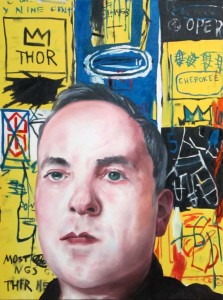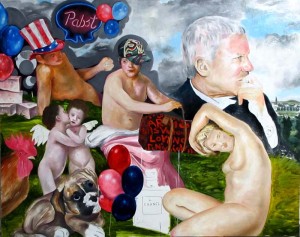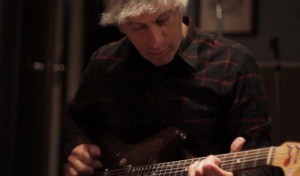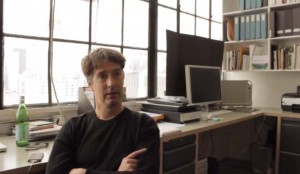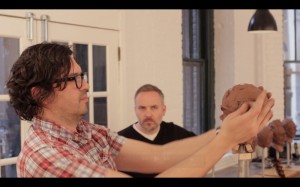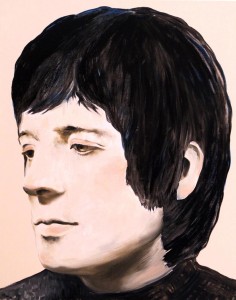Interview with Noah Becker by Meaghan Kent 7.3.13
Meaghan Kent: Shall we start by looking at your work?
Noah Becker: Do you want to see it?
MK: I would love to. I haven’t seen them in person before. Although, I might have, because you did the show at Launch F18 in TriBeCa with Sam (Trioli) and Tim (Donovan), right?
NB: Yes.
MK: These are all self-portraits in this exhibition “Stranger” at Flowers Gallery, London?
NB: Yes. This is a self-portrait that I was working on. It’s part of a series that I’m doing where I’m inserting myself into the canon, as opposed to waiting for people to put me in. Brushstrokes are all outlined with a line on each side and the actual curve of them is really measured. When I’m doing background, I try to keep it in a different state of mind than the figure so this is shifting into more of a classical representation.
MK: So it’s not an exact replication.
NB: Basically, I’m taking a picture of myself and I’m photo-shopping it over the painting. I’m trying to get as close as I can to the feeling of the background, but where there’s drips and that kind of stuff, they’re actually rendered to look like drips, as opposed to actually being drips. So it’s kind of like a way of integrating things that people really recognize. In a sense it is like Warhol, a Campbell soup can or something, he might take a Campbell soup can because he knows that it is recognizable. It’s like a household name. I’m trying to figure out ways of integrating images of modern art that people already directly identify with and somehow integrate it with my work.
MK: I just learned the expression, “selfie.” It has the feel of a “selfie.”
NB: That’s kind of what it is, a photo-bomb or a “selfie.” All of a sudden, I’m just kind of there. It is funny in a certain way, but I don’t really like to use the term “poking fun” because I think that’s a little too much of like a jokey sort of thing.
MK: This ties in a way with the focus on living in New York and the way that you are able to kind of get this rare opportunity here. You can stand in front of a Basquiat pretty easily; even in a gallery setting, you can get pretty close. It’s a unique accessibility that you have here.
NB: On another level, I’m a jazz musician as well as a painter. I play the saxophone. I listen to bebop or I listen to John Coltrane. New York is certainly a melting pot but even when you look at Warhol, it is on a certain level of reality, although it’s famous internationally, local art.
I was born in Cleveland but I grew up in Canada so I’m a duel citizen of Canada and the U.S. When you have something that’s like local art or the local music scene in a small town in Canada, that’s very specific to there. When you get here you don’t think about it as being local art and music. Even though it’s international art as well, it’s local art, and not everything that’s shown in New York is famous in New York as local art.
MK: I definitely feel like there is kind of an art world critique that permeates most of your work.
NB: Yes, it’s getting that way. I also started to collage in elements and work comes out through the editing process. The thing with neon signs, this part of the series of putting the sports bar atmosphere into Italian Renaissance painting- It’s a really ridiculous idea but then as it develops, it gets less ridiculous.
MK: If you think of a historical painter who was doing these day-to-day portraits in casual environments and how that would change if they made work now.
NB: I think that the dark areas in a lot of these old master paintings wouldn’t be dark. If they were doing the exact same work for the first time now, they would be putting things like neon signs and whatever inhabits electrically-lit areas, as opposed to areas that are lit up or not lit up at all.
MK: True. We are not necessarily in darkly lit kinds of saloons anymore. It’s an interesting way of making a painting feel current. The photo-shopping too.
NB: Also on a literary level, just on the basis of how people talk about it, or how it’s written about, or the words that come out of it and these different associations, may not have anything to do with the work. It’s kind of a twist to throw in something that may or may not have anything to do with the references.
MK: So it’s something you’re thinking of kind of randomly, but then changes as it’s coming together?
NB: It’s almost like witchcraft, like every time I do something, like making a voodoo doll, it seems to have some kind of direct implication in my life. It’s just kind of weird.
MK: It seems like a lot of trial and error through the process, but then that final outcome is pretty exact. What is it like when you’re painting another artist’s painting? Like Basquiat, for example.
NB: I try to paint at the speed at which he worked from films that I’ve seen of him painting. Things are just being put down very quickly and very directly. This is another series of British hair models.
MK: Of different celebrities?
NB: No, not celebrities, amateur hair models. I have a lot of portrait stuff a little larger and then smaller but I’m kind of starting to mix it up. Some of those I did in Canada, so also my New York time is starting to kick in in a way, and it’s difficult to work in the same way when you’re in a different place. Things are starting to get a little bit more experimental and have more elements happening in them. I’m being a little more open to Pop art and things that are happening at the time.
My art career started in Miami in 2006 and turned into me wanting to start an art magazine for reasons of almost being driven crazy by being in the art world. I was frustrated. I said to myself, “If I’m going be involved in this, I can’t just have my work sitting in some rack or gallery somewhere being neglected.” I felt like I had the quality and capability to be more of a brand, more like a major gallery or museum rather than be like, “hey, look at my paintings.” I had been an unknown artist for twenty years at that point and had become so frustrated. Also, part of it was the flaws I saw in the publishing world, the way that the art world hadn’t seen its potential online. So I started an online magazine. Prior to this there was only artnet.com and artforum.com.
And this is recent history, not 20 years. In 2006, I was in Canada and when I looked at artnet.com, I would have to click to the magazine part. By the time you’re through, you’ve clicked like four or five times to get to the magazine. artforum.com was mostly paparazzi photos. It’s not like a real art magazine at your fingertips, with real articles and major reviews. It’s not like a virtual art magazine experience. It was websites and I was a person that was interested in a magazine. I still feel like I’ve gained a lot from those places, but as far as online magazines go, I saw that there was something that was missing.
You would bounce from gallery website to gallery website to look at different artists work, and then you would see all the press releases that the gallery manager is doing, and look at all the MFA’s that are graduating who are fluent in art criticism, but then we have to hear from one of the three art critics that were in existence and how they were feeling on that particular day in five or six glossy pages in a magazine. I would read a few articles where the art critics were writing all about them, not really about the work, and I thought at least two of these pages could’ve been devoted to someone unknown, someone starving and dedicated to art and who needs coverage, a small gallery, a small curator, anything- there’s so many people.
So I kind of tapped into the Warhol model there as well, the way Warhol was dealing with superstars and I started to realize there were a lot of people who did not fit the profile of art critic or journalist who could write well and had a valuable perspective on the art world. I put the word out one day that I was going to start the biggest art magazine since artforum.com and artnet. I put out this insane email out through my hotmail account and told my friends that I had quit being an artist, that I couldn’t hack it anymore. I was done, I quit. I grew a beard and never left the house. I woke up the next day and checked my email and I had 800 emails from people stating, “I heard you’re starting a magazine; I’m an MFA from like Pennsylvania”; “I’m in LA and I write”; and on and on. All of these people wanted to write for me and I didn’t even have a magazine, I didn’t have a website. I had never been an editor. I had never done any of that.
Eventually what happened is just because of strange timing, the brand name I had spent time on really caught on and I started making changes to how the site navigated and I got a call from a curator in Belgium who used to teach at NYU, “I know you’re up in Canada, but let’s do a launch festival on the Lower East Side,” and that was in 2007, when the galleries were just getting started there. We said, ok, we’re going to launch a festival for White Hot magazine. Like how Facebook started in 2007, there’s now all these other sites that directly borrow stuff that I kind of pioneered. I borrowed stuff, too, but this kind of online art magazine format, I like to think I pioneered it.
MK: With the film, “New York is Now,” how did you decide on the participants in the film?
NB: Various reasons. For instance, I met Richard Phillips prior because I had written about him.
MK: They were people that you knew or wanted to speak to about a specific time in New York?
NB: Many of these people were also writers, it was more filmic than straight interviews. It wasn’t like “60 Minutes.” I was going to different peoples studios, walking through Chelsea, the Chelsea Hotel, Christie’s Auction House, there are street shots throughout New York.
MK: What brought you to New York originally, and do those reasons still resonate with you today?
NB: I grew up in British Columbia, even though I was born in Ohio, and I’ve always played the saxophone. A drummer, who was a really good friend of mine and has since passed away, started to come down to New York quite often and told me to get out of western Canada and play in a NY jazz band. So my initial inspiration to come to New York was to play jazz. In the ‘90s I was playing regularly in clubs in the New York area. I still do a lot of music stuff. Outside of jazz, there’s not a huge demand for a saxophone. So I started living in these jazz networks of small rooms that were like $400 a month. Jazz musicians had created a secret jazz community in Park Slope. I moved into one of those houses with some very famous jazz musicians, who I’m still in touch with and play with occasionally. I have a jazz musician identity in New York that helped me integrate into the city without directly going into the art scene. After 9/11, I went to Canada for ten years. People started getting interested in the kind of painting I was doing and I moved back to New York.
It’s a question of committing, it’s not a question of being afraid of what you can’t do or what you want to do, it’s a question of committing to the intangible. It’s like a parachute mentality where you hope that it opens.
MK: It’s interesting that you were in this collaborative of jazz musicians, which is very different than meeting people in the art world. People collaborate, but not in the same way musicians do.
NB: Small art community, small music community through the art community. I met some very famous artists. I think I might just continue to make films like the Warhol model. He made films about the people around him making art. The magazine has high level and respected contributors. I do have knowledge of what holds people’s attention and what doesn’t hold their attention. Entertaining people is harder than you might think. You either have it, or you don’t.
Tags: Journal